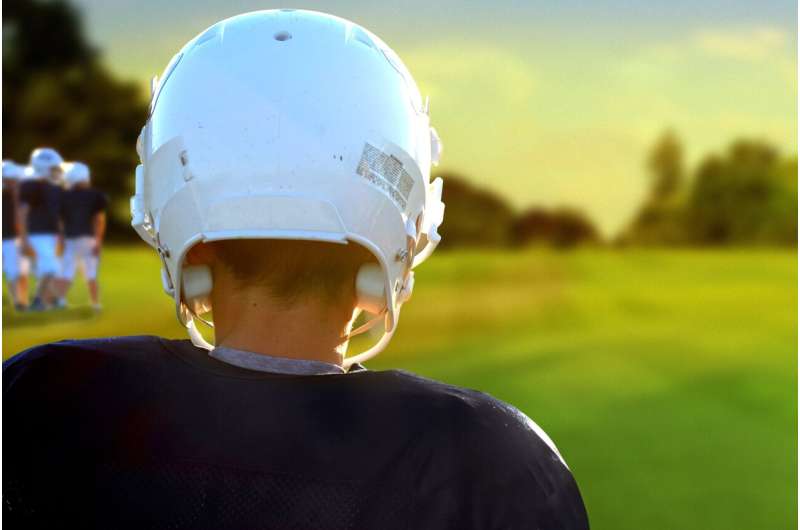This article has been reviewed according to Science X's editorial process and policies. Editors have highlighted the following attributes while ensuring the content's credibility:
fact-checked
peer-reviewed publication
trusted source
proofread
Concussion experts warn term used to describe head impacts—'subconcussion'—is misleading and dangerous

An editorial published in the British Journal of Sports Medicine by experts from Spaulding Rehabilitation, Boston University, Mayo Clinic, and the Concussion Legacy Foundation, argues that the term "subconcussion" is a dangerous misnomer that should be retired. The authors are appealing to the medical community and media to substitute the term with more specific terms so the public can better understand the risks of brain injuries and advance effective efforts to prevent chronic traumatic encephalopathy (CTE).
"The public has been led to believe through media coverage and movies that concussions alone cause CTE," said senior author Dan Daneshvar, MD, Ph.D., chief of Brain Injury Rehabilitation at Spaulding Rehabilitation, a member of the Mass General Brigham health care system, and assistant professor, Harvard Medical School.
"But the research is clear: concussions do not predict CTE status, and the hits that cause concussions are often not the hardest ones, making 'subconcussive' misleading when describing impacts."
The authors believe part of the confusion results from the fact that head impacts that don't cause concussion are referred to as "subconcussive impacts," implying they are less than concussions. Scientists often say that CTE is caused by "small, repetitive impacts," which leaves out the effect of any "large repetitive impacts.".
Ross Zafonte, DO, president of Spaulding Rehabilitation and chair of the Harvard Medical School Department of Physical Medicine and Rehabilitation, served as a co-author.
Previous studies report a high incidence of large repetitive impacts during football. Published helmet sensor studies show that around 10% of head impacts experienced by football players are harder than the average concussion. That means that if a football player gets one concussion during a 1,000 head impacts season, around 100 hits were harder than that one concussion. One study showed that for every concussion a college football player experiences, they experience 340 head impacts of greater force.
The authors of the editorial recommend replacing "subconcussive" with "nonconcussive" to better describe head impacts that don't result in a concussion.
"We've always known CTE is caused by head impacts, but until we did this analysis, I didn't realize I absorbed hundreds of extreme head impacts for every concussion when I played football," said Chris Nowinski, Ph.D., lead author, co-founder and CEO of the Concussion Legacy Foundation, and former Harvard football player.
"Using the term subconcussive naturally led me to imagine smaller hits, but now I suspect these frequent larger hits are playing a more significant role in causing CTE than we previously believed."
The editorial also highlights how the term subconcussive has not only confused the discussion around head impacts, but also around traumatic brain injuries. Studies consistently show that athletes exposed to hundreds of repetitive head impacts, in the absence of a concussion, still have changes to brain function, blood biomarkers of brain injury, and structural changes on imaging that look similar to changes in athletes with diagnosed concussions. The concept of subconcussive injury has been shoehorned into the conversation to explain this "missing link."
The authors suggest we stop using subconcussive injury, noting the missing link is better described as subclinical traumatic brain injury (TBI). Subclinical TBI happens when there are changes in brain function, biomarkers, or imaging without TBI signs or symptoms.
"The human brain has more than 80 billion neurons, and we can be confident an athlete cannot feel it when only one is injured," said neurosurgeon Robert Cantu, MD, clinical professor of neurology, Boston University School of Medicine, and diagnostics and therapeutics leader, Boston University ARDC-CTE Center.
"Athletes, military veterans, and members of the community frequently suffer subclinical traumatic brain injuries, and we suggest retiring subconcussion, a poorly defined term, when referring to brain injuries."
By changing this nomenclature, the authors hope to clarify why concussions do not predict who has CTE, whereas the number and strength of repeated head impacts does. They implore the medical community and media to properly name the impacts and injuries that can't be seen, which can advance the conversation to accelerate CTE prevention efforts, such as the CTE Prevention Protocol.
More information: Christopher J Nowinski et al, 'Subconcussive' is a dangerous misnomer: hits of greater magnitude than concussive impacts may not cause symptoms, British Journal of Sports Medicine (2024). DOI: 10.1136/bjsports-2023-107413



















